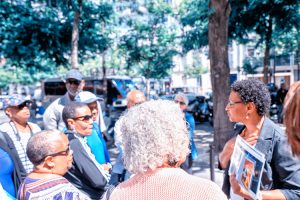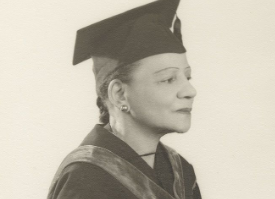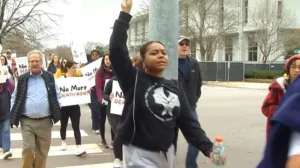 Julia Browne, historian and founder of the Walking the Spirit Tours
Julia Browne, historian and founder of the Walking the Spirit Tours
Julia Browne, historian and tour guide, takes us back to Paris as a meeting place for descendants of Africa scattered across the globe, and is the author of three profiles for Unerased Pathfinders and Patriots. This conversation reveals her love affair with ‘The City of Lights.’ The natural progression was the Black Heritage in France Walking The Spirit tours.
Unerased: What inspired you to launch Black Heritage in France Walking the Spirit tours?
JB: I had long been a Francophile and was inspired by the French language and culture from an early age. I was born in the north of England and emigrated to Canada in 1967 and then moved to France in 1990 — actually on the birthday of Langston Hughes. I have a foot on both continents, but I’m also an instinctual person. I had taken a year abroad in France, and I was there for 18 months. I met someone in France, whom I eventually married.
Five years after I had been in France, I was taking a course at the Sorbonne with the late Michele Fabre. He had written a guidebook on streets that were significant for African Americans in Paris. So, I took this guidebook and walked the streets. I discovered that Langston Hughes had lived in my neighborhood. I was able to walk to his house and go into his attic. I experienced the space where this writer I had always admired, lived and worked. James Baldwin was another example. For this child of West Indian parents, Paris spoke to me. It wasn’t just glittering and bright. It was a place where Black history had occurred. It was personal and inspirational. And I would tell my friends, Did you know that this happened here? And I began taking friends and family around when they would come to town. It was amazing — exhilarating — that Black people had deep roots outside of America.
Unerased: You penned several essays on Black expatriates for Unerased, how did you select the women you profiled?
JB: I decided to look at women from the 1920s, a time of great change for Black women. I immediately chose these three Black women, Nancy Elizabeth Prophet, Paulette Nardhal and Ada Smith, aka Bricktop because their Parisian experiences were very different with very different outcomes.
Prophet had such a heartbreaking experience. She moved heaven and earth to get there, scraping together $300 to get there, plus dragging along a husband. It was hard even finding a place to live. In France emerging from World War I, times were hard. Expatriates with plenty of cash could make it, but for those without money, it was a different story. “Creating through hell” is the way she put it. She stayed 12 years, longer than any of the other Black ex-pats of that era. Her talent as a sculptor was finally recognized in Paris, which led to art shows that eventually led to recognition in the U.S. As a Black woman, that would never have happened in the United States. Going to Paris was the ticket that gave Black artists credibility.
When we talk about Black history, Black Americans are usually the focus. But France in the 1900s was a meeting place for the global Black Diaspora. Paulette Nardhal led the charge to appreciate the diversity of that experience. She was the first Black person to study at the Sorbonne in 1920. She was very much an activist. Born to an upper-class family in Martinique, she spoke English and French. She could write about what was happening in the Caribbean literary circles when Caribbean writers started coming in in 1924 and 1925. She was the editor of a review that gave voice to all parts of the Black Diaspora. The review spread the message further into Africa and the Caribbean. She helped launch the Negritude movement for which she never received credit. Nardhal was extraordinarily influential and not just among the Black expatriates. She was one of seven sisters, and together they created a literary salon that attracted the top writers, scholars, intellectuals, and artists. It was a woman’s search for power.
And I chose Ada Beatrice Queen Victoria Louise Virginia Smith who won the nickname Bricktop because when people think of Black people in France in the 1920s, they think of entertainers. Entertainers were the public face of the Black world in France. Bricktop was already a well-known entertainer when she arrived. She opened a new club that welcomed everyone — Black writers, entertainers and White artists and patrons. She was the center of the wheel in the white arts community. F. Scott Fitzgerald, Ernest Hemingway, Cole Porter — they all buzzed around her. She was also a close friend of Eslanda Robeson, Paul Robeson’s wife. That was her gift–bringing people together. People talk about Josephine Baker, but Bricktop made it possible for all those worlds to meet on an equal footing.
These three women provide a perspective on what Black women were doing in the 1920s. When Nancy Prophet saw Black art, she found something that resonated with her. When Eslanda Robeson started traveling in Africa, those experiences shaped her view. All of these women were instrumental in moving that conversation.
Unerased: What lessons/examples do they offer for Black artists and activists today?
JB: For me, history is always a teacher. You look back and try to learn about what other people went through, their resolve and their obstacles. We’re living in a much different world. And so it’s good to know that these struggles have been going on for a long time. Maybe five years ago, the Musée du Quai Branly, which focuses on non-western art’s influence on western art, had an exhibition on Black art and politics called the Color Line, sharing how Blacks used art and music for activism. One of the things that surprised me is the piece about Billie Holiday’s song, Strange Fruit. I hadn’t realized that the song was about lynching. The museum recreated an exhibition by DuBois for the World’s Fair on the Black middle class and urban class. And people were shocked to find out that all Blacks weren’t impoverished. I looked at works different artists had created. Being subversive but also being vocal is very important. There’s much value to studying where we come from, what we’ve done and the outcomes. And so much to guide us in hope and encouragement. And they are also using their self-expression. It’s not just marching in the streets, which is very important. But there are other ways to express that sentiment.
Unerased: How has the Black experience in Paris changed or remained the same since the era you wrote about for Patriots and Pathfinders?
JB: Paris today, as it was a hundred years ago, is more visibly multiracial because of immigration. The word “community” is troublesome. There are people of African, Caribbean, and American origins. Those communities don’t necessarily come together. They all have different experiences. There’s a European Black Lives Matter movement, but it’s not about the North American Black experience. There were Black Lives Matter marches in 2020, but they weren’t focused on George Floyd. They were focused on police brutality in their populations. The word “Black community” is problematic. In North America, we have our own container. In Europe, the community is different because it flows from many strands. France claims that we are all the same; we are all French.
When you speak about the Black community in France, that’s considered divisive. That’s the idealistic view Liberte, Egalite, Fraternite. People who are third-generation Black French, their parents toed the line. Are we calling ourselves Black, are we using the word Noir? Are we Afro-French or Afro European? If you’re born in France and you’re third or fourth generation, you’re firmly French. But you have to stand your ground, we are Black, or Noir.
France always saw itself as colorblind. When I started doing tours in the 1990s, recognizing that people of color were separate from others was not acknowledged. There was no census. We are all one in France. The need for recognition — to hear diverse voices — is now on the table. There’s also the younger generation not feeling confident in being heard. How do you make yourself heard? It has long followed the American model which Black Americans have projected. The push forward in visibility–of having Blacks in media, television shows and music has been the example. It’s fascinating to see how the world unfolds.
Unerased: What about immigration in France?
JB: The migrant issue has forced reactions. People are putting up walls faster than you can imagine, bringing on the louder voices of the nationalists and right-wing. But in many cities the mayors have been doing a lot to create welcoming environments. You see tent cities established to house migrants. You also see the explosion of multinationalism and multiculturalism: Black businesses, African restaurants, African clothing. Paris has become a center for African fashion. We include the African district on our tours, and people love it. Join Julia Browne on a quick walking tour of James Baldwin’s Paris adventure here.
Julia Browne also collaborated with documentary filmmakers Joanne Burker and David Burke in the production of the award-winning film Paris Noir: African Americans In the City of Lights. Visit here a glimpse of the film and more on Blacks in Paris.
This is an updated version of an interview which first appeared in 2020.




